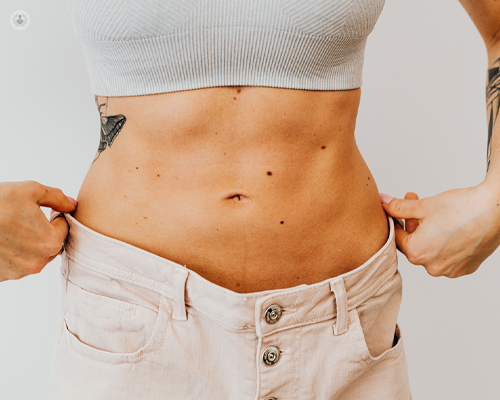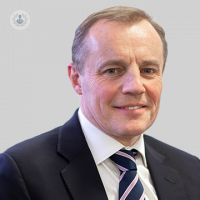Is a tummy tuck right for you?
Escrito por:If you’re thinking about having an abdominoplasty, also known as a tummy tuck, you may wonder If it will be suitable for your bodies needs, as well as your looks.
Finding objective advice from an expert can be invaluable, and leading consultant plastic, aesthetic and reconstructive surgeon Mr Paul Roblin is here to give a balanced take on why - or why not - a tummy tuck is right for you.

What are abdominoplasties?
The removal of excess skin and fat from the lower abdomen is involved in an abdominoplasty, or tummy tuck. It results in a waistline that’s slimmer and a body contour that’s improved. In conjunction with this, tightening of the abdominal walls may be performed to enhance the abdominal contour.
Abdominoplasty is a procedure that is frequently done on its own but can also be used in combination with others. For example, liposuction or buttock, thigh, and arm lifts in those who’ve lost significant amounts of weight.
An abdominoplasty may also be extended to remove excess tissue from the flank and back, and this procedure is called a circumferential body lift.
What are the reasons for people to have an abdominoplasty?
The skin’s elasticity is reduced and its ability to take up its former shape is lost with increasing age. Unwanted fat and excess skin may remain in the lower abdomen, despite diet and exercise. Also, weight changes and pregnancy, particularly those who have had multiple pregnancies, can also lead to excess lower-abdominal tissue.
The skin can be stretched beyond its ability to return to its pre-pregnant state. If retraction of the skin hasn’t taken place after a year, then it’s unlikely it will ever happen. Pregnancy, alongside stretched skin, can also lead to separation of the rectus muscles. This may weaken the abdominal wall, and in some cases, produce bulging.
What are the reasons to have an abdominoplasty?
While an abdominoplasty may be used as an additional part of a long-term structured program to reduce weight and achieve a good end result, it isn’t a treatment for obesity in itself.
The incidence of complications from an abdominoplasty can increase with being overweight and smoking. Until smoking has stopped or cut down, and a proportion of excess weight lost, it may be wise to delay surgery. However, it may not be wise to proceed if you have pregnancy plans for the future. Also, previous abdominal surgery may mean that an abdominoplasty isn’t permitted.
If you take aspirin, you’ll be asked to stop this for at least ten days before the procedure. This is because it increases the risk of bleeding by preventing blood from clotting.
What happens in an abdominoplasty consultation?
I examine the patient, particularly looking for excess tissue, its extent, and for bulging or hernias. In addition, abdominal wall strength will be tested.
You will first be asked about your general health, particularly information regarding:
- Heart disease;
- Diabetes, and;
- Deep vein thrombosis (blood clots in the leg).
I also take your medical history and information about any previous surgical procedures, alongside weight changes, previous pregnancies and planned pregnancies for the future.
Then I will discuss which procedure is the most appropriate to achieve the optimal result in your individual case and in line with your aims.
What types of abdominoplasties are there, and what is the procedure for them?
Standard abdominoplasty
Most, or all of the skin below the umbilicus (belly button) is removed. The skin that’s remaining is pulled down and re-draped over the abdomen. In order to camouflage this, a low abdominal scar is placed on the underwear line. A short, vertical scar maybe necessary on occasion. At its original site, the umbilicus remains in position and the resulting scar around the umbilicus is usually concealed.
Mini-abdominoplasty
A reduced amount of abdominal tissue is removed in this procedure. This may be augmented with a moderate degree of liposuction to remove fat from the flank and upper abdomen, and a shortened abdominal scar is left. The umbilicus remains in its original position, with no scar surrounding it.
Mini-abdominoplasty is only suitable for a small proportion of patients. The majority of excess tissues and fat is found below the umbilicus.
Circumferential or extended abdominoplasty
This is for those who require more extensive tissue removal, including tissue from the flank and back. It results in a longer scar, which goes onto the back, and may lead to having a vertical scar in the midline. This procedure is most commonly used in those who have undergone weight-reducing surgery, and/or have lost large amounts of weight.
Muscle tightening
The abdominal muscles may be lax, alongside skin and fat that needs to be removed. They can be tightened, which helps to give the abdomen a more flattened appearance. This procedure can be combined with any type of abdominoplasty.
The operation is performed under general anaesthesia and takes approximately two hours, and the length of hospital stay is between one to two nights following the operation.
What are the risks or possible complications involved in abdominoplasty?
Tummy tuck risks can be separated into risks early on, and later, after one week.
Early (One to two days)
- Discomfort
- Bruising
- Bleeding (haematoma)
- Swelling
- Wound breakdown
- Infection
Later (after one week)
- Seroma formation
- Residual deformity - occasionally, a second, smaller procedure is required
- Asymmetry
- Misaligned umbilicus
- Scars, which can be lumpy, may stretch and widen
- Contour irregularity
- Temporarily-reduced sensation in lower abdomen
- Delayed wound healing
- Skin or umbilical necrosis
- Fat necrosis
- Deep vein thrombosis
- Allergic reaction to drugs or tape
- Chest infection
What is involved in recovery from abdominoplasty?
You will feel bruised and sore, and there will be some swelling immediately after the operation. The pain is usually moderate and controlled with standard painkillers, and two drains will be in place that should stay in when you go home.
For the following two weeks, a compression garment is to be worn day and night. Patients shouldn’t do any heavy lifting or straining, but walking is encouraged.
After you return home, you can return to work and drive after two to three weeks, while swelling and bruising will last for up to six to eight weeks.
You must wear the compression garment provided throughout the day for six to eight weeks, while you should return to the gym and undertake strenuous activity after three months.
The final result will be between four to six months and it’s permanent, unless there’s weight gain or future pregnancy.
If you’re considering an abdominoplasty, arrange a consultation with Mr Roblin via his Top Doctors profile.


